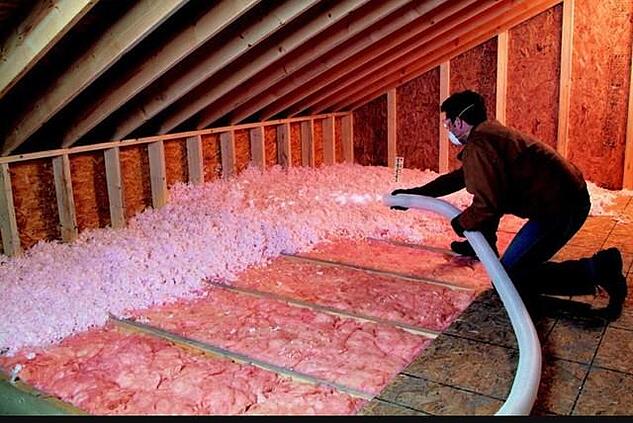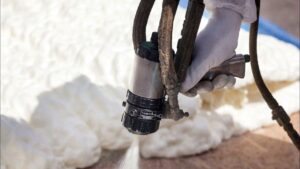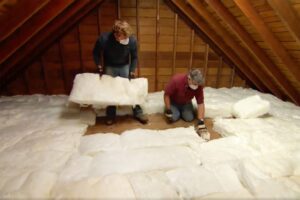Attic insulation is one of the most effective ways to reduce heating costs during the colder months. Insulating your attic properly can save homeowners up to 15% on annual heating bills, according to the U.S. Department of Energy. This not only lowers energy costs but also increases comfort by maintaining consistent indoor temperatures. Proper insulation can also reduce the strain on heating systems, potentially extending their lifespan. With rising energy prices, understanding how attic insulation can help reduce heating costs is essential.
In this article, we will examine how attic insulation works, the types available, and the factors that should be considered before upgrading your insulation. Additionally, we’ll address frequently asked questions and provide tips for homeowners looking to reduce their heating costs through attic insulation.
How Attic Insulation Works to Reduce Heating Costs
During winter, heat tends to rise within the home, escaping through the roof and attic if not properly insulated. Insulation in the attic helps slow down this heat transfer, trapping warmth inside and preventing it from escaping into the colder outdoor environment. As a result, your heating system does not have to work as hard to maintain a comfortable indoor temperature, leading to reduced energy usage and lower heating bills.
The amount of heat lost depends on several factors, including the R-value of the insulation, the materials used, and the overall air sealing in the attic. Higher R-values, which indicate better thermal resistance, contribute to better heat retention and increased energy efficiency.
Types of Attic Insulation
Selecting the right type of insulation is crucial for achieving the best results. Each insulation material has different characteristics and is suitable for specific attic conditions. The following table compares the most common attic insulation types, helping homeowners make an informed decision.

| Insulation Type | R-Value per Inch | Air Sealing Capability | Moisture Resistance | Typical Use Cases |
|---|---|---|---|---|
| Fiberglass Batts | 2.9 – 3.8 | Low | Moderate | Standard attics, easy installation |
| Blown-in Cellulose | 3.2 – 3.8 | Moderate | Low | Retrofit projects, irregular spaces |
| Spray Foam (Open-Cell) | 3.5 – 3.6 | High | Low | Soundproofing, interior applications |
| Spray Foam (Closed-Cell) | 6.0 – 6.5 | High | High | Moisture-prone areas, high R-value needs |
Fiberglass batts are a traditional choice for attic insulation, offering an affordable option for standard attic spaces. However, they are not particularly effective at sealing air leaks and can be prone to moisture damage if not installed correctly. Blown-in cellulose insulation, made from recycled paper products, is a popular choice for retrofitting homes due to its ability to fill gaps and cover irregular spaces. However, it offers moderate moisture resistance, which can be a concern in certain areas of the attic.
Spray foam insulation, especially closed-cell spray foam, provides the best air sealing and moisture resistance. Closed-cell foam has a higher R-value per inch, making it ideal for colder climates where insulation performance is critical. Open-cell spray foam, while not as moisture-resistant, can still provide excellent air sealing and soundproofing, making it useful in interior spaces.
Bonus Tip: Closed-cell spray foam offers superior moisture resistance, making it ideal for regions with high humidity or potential water intrusion.
Recommended R-Values for Attic Insulation
The R-value of insulation measures its resistance to heat flow; the higher the R-value, the better the insulation’s performance. For attics, the recommended R-value depends on the local climate, as different regions experience varying temperatures and weather conditions. Below is a table outlining the suggested R-values for attic insulation in different climate zones:
| Climate Zone | Recommended R-Value | Approximate Insulation Thickness |
|---|---|---|
| Warm (Zones 1-2) | R-30 to R-49 | 9 to 15 inches of fiberglass |
| Moderate (Zones 3-4) | R-38 to R-60 | 12 to 20 inches of fiberglass |
| Cold (Zones 5-7) | R-49 to R-60 | 16 to 20 inches of fiberglass |
In warm climates, R-values between R-30 and R-49 are typically sufficient. For moderate climates, R-38 to R-60 is often recommended. In colder regions, higher R-values of R-49 or more are needed to prevent significant heat loss and reduce heating costs effectively.
Bonus Tip: Achieving an R-value of 49 or higher in colder climates will provide better energy savings and maintain more consistent indoor temperatures.
Market Trends in Insulation
The insulation market has been expanding rapidly due to increasing energy costs and rising awareness about energy efficiency. As more homeowners seek ways to reduce heating bills and improve home comfort, the demand for high-performance insulation materials like spray foam has grown. According to market research, the global insulation market was valued at USD 65.11 billion in 2023 and is expected to grow at a compound annual growth rate (CAGR) of 6.8% from 2024 to 2030. This growth reflects a broader interest in improving energy efficiency across both residential and commercial sectors.
In North America, the insulation market is also projected to grow at a steady rate, driven by government regulations and incentives that encourage energy-efficient building practices. The U.S. Department of Energy estimates that improving attic insulation alone can save homeowners between 10% and 50% on heating and cooling costs, which makes it a key area of focus for energy conservation efforts.
Factors to Consider Before Insulating Your Attic
Before upgrading attic insulation, homeowners should evaluate several factors to ensure they make the best decision for their home and budget.
Existing Insulation: Start by assessing the current insulation in your attic. If it’s damaged, compressed, or inefficient, replacing or adding insulation may be necessary. In some cases, it may be possible to add insulation on top of the existing material, but it’s essential to verify that the current insulation meets performance standards.
Air Sealing: Proper air sealing is a critical step before installing new insulation. Air leaks in the attic can significantly reduce the effectiveness of insulation, allowing heat to escape and increasing energy costs. Sealing gaps around vents, ducts, and plumbing pipes ensures that the insulation will work as intended.
Moisture Control: Moisture can be a significant issue in attics, especially in humid climates. If moisture is allowed to build up, it can lead to mold growth, insulation degradation, and potential damage to the home’s structure. If your attic has moisture problems, it’s crucial to address them before adding new insulation.
Ventilation: Proper attic ventilation is essential for maintaining a healthy environment and preventing moisture buildup. Poor ventilation can lead to condensation problems, which can reduce the efficiency of the insulation. Make sure that vents are not blocked and that there is sufficient airflow in the attic.
Budget: Installing attic insulation can be a significant investment. While the upfront cost may vary based on the type of insulation and the size of the attic, the long-term savings on heating bills will likely make it a worthwhile investment. Consider your budget and explore different insulation options to find the one that provides the best value.

Bonus Tip: A home energy audit can help pinpoint areas where insulation improvements will be most effective, ensuring that you get the most out of your investment.
Common Questions About Attic Insulation
How does attic insulation reduce heating costs?
Attic insulation prevents heat from escaping through the roof, helping to maintain the indoor temperature. This reduces the demand on the heating system, resulting in lower energy consumption and heating costs.
Can I install attic insulation myself?
Some types of insulation, such as fiberglass batts, can be installed by homeowners with basic DIY skills. However, spray foam insulation and blown-in cellulose often require professional installation due to the complexity of the process and safety concerns.
How long does attic insulation last?
Most insulation materials, such as fiberglass and cellulose, can last for 20 to 30 years. However, their effectiveness can diminish over time, especially if exposed to moisture or physical damage.
Is it necessary to remove old insulation before adding new?
If the existing insulation is in good condition and has not been damaged by moisture or pests, you can often add new insulation on top. However, damaged or contaminated insulation should be removed.
Does attic insulation improve home comfort?
Yes, attic insulation helps maintain consistent indoor temperatures, reducing drafts and cold spots. This leads to improved comfort during the winter months.
Make the Right Decision
Investing in attic insulation is an effective way to reduce heating costs and improve comfort during the winter. Proper insulation can provide substantial savings on energy bills and help maintain a comfortable living environment. By choosing the right insulation type, addressing air leaks, and ensuring proper ventilation, homeowners can maximize the benefits of their attic insulation.
Author and Reviewer:
Author: Bob Gasca attended his first spray foam training in 2007 and has continued to pursue yearly training to stay current with the latest technology and practices. He is a certified Spray Foam Master Installer through the SPFA and a member of the SPFA. Additionally, Bob serves as a Spray Foam Worldwide Ambassador, sharing information with spray foam professionals globally. Recently, he returned from a building science training, where he expanded his knowledge on how weather conditions affect home performance, helping him better diagnose and improve home health for families. Bob specializes in finding solutions to complex moisture and air infiltration issues.
Reviewer: Noah Gonzalez reviewed this article and drew on 9 years of experience to offer suggestions that make the guidance more directly useful for insulation contractors.




